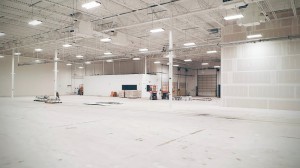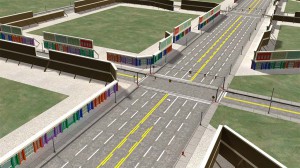A 300-acre portion of Michigan’s historic manufacturing past is taking another step toward the auto industry’s technological future.
The Willow Run Arsenal of Democracy Landholdings Limited Partnership just completed the $1.2 million purchase of the former Willow Run Assembly Plant near Detroit from RACER Properties LLC, which will allow for the construction of the autonomous testing and development facility of future mobility named the American Center for Mobility.
The site churned out thousands of bombers during World War II as a key component of the Arsenal of Democracy is now part of an $80 million investment to bring viable autonomous vehicles to the U.S., starting with the use of this site as a testing facility starting in 2018.
The facility not only serves as leading edge testing facility, but some may argue as the key to a shift in moving this type of testing and the overall development of self-driving vehicles from Silicon Valley to Michigan.
It served as a key part of the Arsenal of Democracy during World War II, but the site of the old Willow Run Assembly Plant, just outside Detroit, could come back to life as part of the auto industry’s future.
(The Arsenal of Democracy could be reborn for the autonomous era. Click Herefor the latest.)

Google is opening a development center in Novi, Michigan. This building will start work with 100 Chrysler Pacific autonomous minivans.
Until now, most of the research on self-driving cars has taken place in California and other warm-weather states. The ACM would allow automakers and suppliers to test their technology in a broader range of climactic conditions.
However, since Google began buzzing around its headquarters in Mountain View, California, testing cars equipped with its system and then later with its own cars lacking steering wheels as well as gas and brake pedals, automakers have been scrambling to catch up.
As a result, a lot of the “catch up” has been taking place closer to the historic home of the Big Three: Detroit, including at the University of Michigan as well as at the testing facilities already in place for American carmakers.
That said, recent changes suggest that the early leaders in the movement – technology companies – may be watching their brainchild slipping from their grasp.
In fact, the behemoth that catalyzed the industry, Google, recently opened a new testing facility in Novi, Michigan, a Detroit suburb, and is rumored to be looking to get out of the production of the autonomous vehicles, content to simply supply the autonomous system for an automaker.
Add to that that the other tech giant industry observers waited for to make an impact, Apple, now appears to be getting out of the business, which it never formally announced it was in to begin with. Recent reports show that Apple is looking to shut down the much-rumored Project Titan sometime next year.
(Two crumbling Michigan relics of the World War II fight could find new life. Click Here for more.)
Really, the move to Michigan makes sense for a number reasons perhaps the most compelling being the weather. Until now, most of the research on self-driving vehicles has been done in relatively benign climates, in places like Silicon Valley and Phoenix. The real challenge will be to get the technology to work in more adverse environments, such as a Michigan winter.
Some testing has already begun in the state. Detroit’s Big Three automakers own their own Michigan test tracks, as do some other car companies and suppliers, including Toyota. And, in 2015, the University of Michigan opened its 32-acre MCity complex in the university town of Ann Arbor. At nearly 10 times the size, the American Center for Mobility would allow researchers to better simulate real-world conditions, backers have suggested.
It would also allow manufacturers and government officials to work together on some projects. Last January, the National Highway Traffic Safety Administration announced a joint industry/government consortium aimed at speeding to market new safety technologies – including both vehicle-to-vehicle communications and autonomous driving systems.
The Willow Run facility was built by Ford in 1941 and soon converted to a heavy bomber plant. It was a manufacturing wonder during the War, rolling out nearly half of the B-24 Liberators produced through May 1945, nearly one an hour.
After bomber production ended, Ford walked away from the facility and it was briefly used by the short-lived Kaiser-Frazer Corp. before being sold to General Motors in 1953. GM ran two factories on the property, a transmission line and a vehicle assembly plant, shutting down the last of the operations in 2010.
(Automakers can’t sacrifice safety in rush for autonomous vehicles, cautions US Transportation Sec. Foxx. Click Here for the story.)
The old airport continues to be used, primarily for cargo flights, and a portion of one old GM plant is being converted into the permanent home of the Yankee Air Museum. But most of the site has been abandoned for years.

